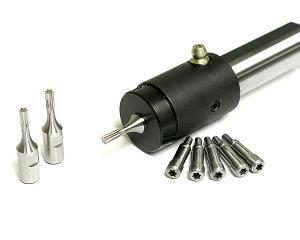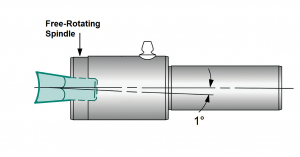Rotary Broaching: The Hole Thing Takes Shape
Rotary Broaching: The Hole Thing Takes Shape
Solving manufacturing problems through rotary broaching
 When people hear the term “broaching”, most think of conventional step broaching, which involves pushing or pulling a toothed bar through a part on a press. It is a method that has been around since the beginning of (manufacturing) time. The problem with conventional broaching is that it has application limitations and cost/efficiency drawbacks. For example, conventional broaches can only be used in through-hole applications. Also, it must be performed as a secondary operation on a press. Costs and manufacturing lead times for conventional step broaches can be exorbitant. A newer manufacturing method called “rotary broaching” addresses these problems and can outperform conventional broaching in these areas.
When people hear the term “broaching”, most think of conventional step broaching, which involves pushing or pulling a toothed bar through a part on a press. It is a method that has been around since the beginning of (manufacturing) time. The problem with conventional broaching is that it has application limitations and cost/efficiency drawbacks. For example, conventional broaches can only be used in through-hole applications. Also, it must be performed as a secondary operation on a press. Costs and manufacturing lead times for conventional step broaches can be exorbitant. A newer manufacturing method called “rotary broaching” addresses these problems and can outperform conventional broaching in these areas.
Rotary broaching is a rapid machining method that cuts shapes into or onto a workpiece. It involves using a broach, which is ground to the finished desired form, and a rotary broaching tool holder on a lathe or mill. One large advantage of the rotary broaching process is that it can be used in blind or through-hole applications. Because this process can be used on any CNC lathe or mill, another positive characteristic of rotary broaching is that it can be done at the same time as other turning or machining operations, so there is no down time changing machines. Additionally, the cost of a rotary broach is a fraction of the cost of a conventional broach with minimal to no lead time.
 The rotary broaching tool holder has a free-rotating spindle on the front end, which holds the broach at a 1 degree angle. The broach is driven by the workpiece so no live tooling is needed. In a lathe, upon contact with the workpiece, the broach and tool holder spindle will begin to rotate 1:1 with the workpeice while the body of the tool holder is held stationary. In a mill, the workpiece is stationary, so the broach and tool holder spindle will remain stationary while the tool holder body rotates in the machine’s spindle. The 1 degree angle that is built into the tool holder allows the broach to have only one point of engagement at a time. By only having one point of contact cutting at a time, very little thrust is required from the machine, which makes broaching possible to do on virtually any lathe or mill. The whole process is completed in about the same amount of time as a drill cycle and creates a form within .0005” tolerance.
The rotary broaching tool holder has a free-rotating spindle on the front end, which holds the broach at a 1 degree angle. The broach is driven by the workpiece so no live tooling is needed. In a lathe, upon contact with the workpiece, the broach and tool holder spindle will begin to rotate 1:1 with the workpeice while the body of the tool holder is held stationary. In a mill, the workpiece is stationary, so the broach and tool holder spindle will remain stationary while the tool holder body rotates in the machine’s spindle. The 1 degree angle that is built into the tool holder allows the broach to have only one point of engagement at a time. By only having one point of contact cutting at a time, very little thrust is required from the machine, which makes broaching possible to do on virtually any lathe or mill. The whole process is completed in about the same amount of time as a drill cycle and creates a form within .0005” tolerance.
Any shop that has a CNC machine can benefit from rotary broaching. Whether machining a form into a blind or through hole, or cutting an external shape onto a part, the rotary broaching process is an excellent option to consider. Manufacturers utilizing the rotary broaching process have been able to bring broaching back in house and drastically cut machining times and costs. In fact, many manufacturers are altering their machining methods to this technology from other more costly methods, such as milling, EDM wire cutting, or knurling. Some of the industries currently benefitting from rotary broaching are manufacturers of aerospace fasteners, medical implants, plumbing fixtures, and automotive parts.
While it has many advantages, there are some boundaries to rotary broaching. For instance, forms over 2 inches are not recommended for this process. Additionally, for applications involving a broaching depth in excess of an inch, rotary broaching can be difficult. With these types of applications, conventional broaching may be a better option. Small forms at shallow depths is the motto to remember with rotary broaching. A multitude of materials can be successfully rotary broached including but not limited to alloy steel, brass, aluminum, stainless steel, titanium and plastics.
When considering rotary broaching as a solution, it is always recommended to send a portion of your print of the area to be broached to ensure success. The decision to change your manufacturing process to include rotary broaching can reduce time, increase profits and improve quality to give you a significant advantage over competitors. To learn more about rotary broaching, contact Slater Tools Inc. at 586-465-5000 or direct@slatertools.com.
